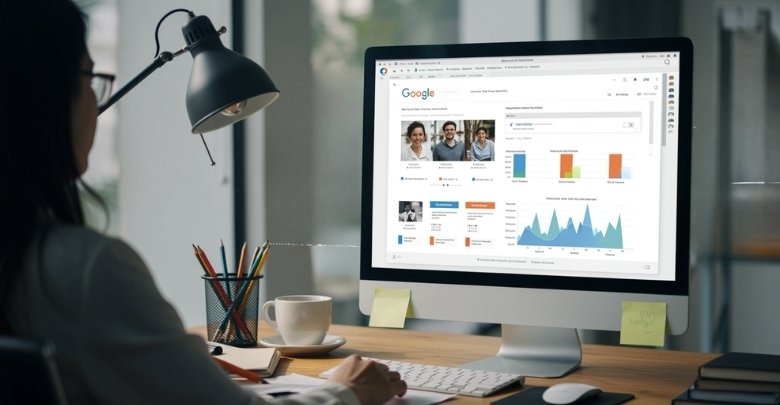Adding your conference papers to Google Scholar helps more people see your research and makes it easier for others to find and cite your work. Google Scholar is a free tool that lets you showcase your studies online and build your academic profile. It is important to keep your profile up to date so your work gets noticed. This can help you connect with other students and teachers.
Do you want to know how to add conference paper in Google Scholar?
Add a conference paper to Google Scholar by signing in at scholar.google.com, accessing your profile, and clicking “Add.” Choose “Add article manually,” then enter the paper’s title, authors, abstract, date, and conference name. Upload a PDF if permitted, then click “Save.” Google Scholar will index it shortly.
Read on for a detailed, step-by-step guide!
How to Add Conference Paper in Google Scholar?
Adding your conference paper to Google Scholar helps other students and teachers find your work easily. Google Scholar lets you create a profile where you can list your research and papers. Following these simple steps will help you share your paper with everyone online.

1. Make Your Google Scholar Profile
- Begin by going to scholar.google.com and signing in using your Google account.
- Click the “My Profile” icon at the top-right to create your profile if you don’t have one yet.
2. Open the Add Paper Option
- On your profile page, you will see the “Add” button in the top-left corner.
- Click it, then choose “Add articles” or “Add article manually” from the drop-down menu.
3. Fill in the Paper Details
- Carefully enter the title, authors, abstract, publication date, and the conference name as the venue.
- Double-check your details to make sure everything is correct before moving on.
4. Submitting Your Conference Paper (Anchor Included)
- If you have a PDF of your paper, upload it, but only if you have the right to share it.
- Sharing your research matters in academic events, and submitting your conference paper helps others access your work directly.
5. Save and Check Your Paper
- After entering all the details, review everything once again for mistakes.
- Click “Save” to add your conference paper to your profile.
6. Wait for Indexing
- Google Scholar will start indexing your paper, which might take some time to appear in search results.
- Keep checking your profile and update any information or upload new versions if needed.
Why Add a Conference Paper to Google Scholar?
Google Scholar is a place where students, teachers, and researchers look for useful information and new ideas. By sharing your paper here, you make it easier for others to find your work and learn from it. Here are more reasons to add a conference to Google Scholar.
Your Work Is Easier to Find
When your paper is on Google Scholar, people all over the world can find it quickly. This means more students and teachers can read what you wrote. Your research becomes easier to find for anyone who searches for your topic.
If someone is interested in your subject, your paper could show up in their results. More people will see your ideas, and you may get more feedback. This is a great way to make your research more popular and helpful.
You Can Show Your Achievements
Adding your paper helps you build a strong profile on Google Scholar. People can see your work and how many times it has been used or cited. This shows you are active in research and helps you gain respect.
You can see how many people have cited your papers through the numbers on your profile. These numbers can help show teachers and other researchers that your work is important. It can also help you with school projects and future studies.
Your Research Is Easy to Use
When your paper is on Google Scholar, others can use your work for their projects. They can easily find and cite your research in their own papers. This helps your ideas reach more people and get used in new studies.
The more your paper is cited, the more impact your research has. Other students and researchers can learn from your work. This can help your research grow and reach new places.
Your Work Stays Online
Google Scholar keeps your paper safe and easy to find for a long time. Even after your conference ends, your work will not disappear. Future students and teachers can still read and use your research.
Your research becomes part of a big online library. This helps your work last for many years and helps others who are interested in your topic. Your paper will not get lost, and people can always find it.
Meet and Connect With Others
Listing your conference paper can help you meet new people who are interested in your topic. Researchers may contact you to ask questions, share ideas, or work together on new projects. This can help you learn more and make new friends in your field.
Many conferences are held in countries like the United States, Germany, and Canada. For example, upcoming conferences in Canada bring together students and experts from many places, so sharing your paper can help you connect with them. These connections can help you in your studies and future research.
Factors You Should Check Before Adding Your Conference Paper to Google Scholar
Adding a conference paper to Google Scholar is exciting, but you need to check a few things first. It’s important to know what makes a paper right for Google Scholar. If you miss any step, your paper may not show up well or be easy to find. Let’s look at some simple things you should always check before you upload your paper.
Scholarly Content
First, make sure your paper is scholarly and not just a classroom project or simple summary. Google Scholar usually accepts papers that have been reviewed by experts or published at good conferences. If your paper has been presented at a big conference or printed in a journal, it’s a good sign. Scholarly papers are more trusted and respected in the academic world. This gives your work more value.
Unique Web Link
Every conference paper you want to add should have its own special link on the internet. This link should lead straight to your paper and not to a general website or a homepage. Make sure your paper is easy to open without lots of searching or clicking around. If your paper is hard to find, people might skip it. Having a clear and working web link is really important.
Clear Abstract
Your paper should have an abstract, which is a short summary written by you or your group. The abstract must be easy to find and read on your paper’s web page. Make sure the full author-written abstract is there, not just a few sentences. People read the abstract to decide if they want to read your whole paper. A good abstract helps others understand your work faster.
Conference and Journal Quality
Before you upload, think about the quality of the conference where you presented your paper. Good conferences and journals are respected and get noticed more often by Google Scholar. If you are not sure, ask a teacher or search for the conference online. Reputable places make your research look better. Papers from low-quality conferences may not get much attention.
Paper’s Impact
It helps if your paper has already been talked about or cited by other researchers. Look for citation counts if you can. This shows your paper has made a difference and is being used by others. Even if it’s new, a clear and well-structured paper gets more views. Sometimes, you can learn from how structure conference papers are structured to make your own work stronger and easier to read.
Open Access
If your paper is free to read for everyone (open access), more people can find it and use it. Open-access papers often get indexed by Google Scholar faster. This means your work can reach more students and researchers. If you can, choose to make your paper open access. Ask if your school or group can help pay any fees needed for this.
Correct Paper Details
Please make sure all the details, such as the title, your name, and the conference name, are typed correctly when adding your paper. Wrong or missing details can make your paper hard to find. Double-check your information before clicking save. Google Scholar uses these details to show your paper to the right people. Accurate details are important to your paper’s success.
Tips for Ensuring Your Paper is Indexed
Making sure your paper gets noticed on Google Scholar is important if you want others to find and read your work. Sometimes, a paper doesn’t show up just because of small mistakes. If you follow a few simple tips, you can help your paper get seen. Let’s check out some easy ways to help your paper get indexed.
Make It Public
Your paper needs to be easy for everyone to find and read online. If you hide it behind a password or special login, Google Scholar might not find it. Always upload your paper so that anyone can view it. This could be a school website, conference site, or a trusted preprint server. The more open your paper is, the more people can see it.
Use Good Formatting
A well-formatted paper is easier for Google Scholar to understand. Always include a clear title, a list of authors, an abstract, and a bibliography. If your paper is messy or missing parts, it might not get picked up. Check that everything is neat and in the right place. Clear formatting helps everyone understand your work better.
Choose Trusted Websites
Google Scholar trusts some websites more than others when it comes to finding new papers. Try to use conference websites, university pages, or other academic sites to host your paper. Avoid websites that don’t look official or are full of ads. When your paper is on a trusted website, it has a better chance of being indexed.
Link on Your Website
If you have a personal or school website, make sure you add a link to your paper. Put your paper on your publications or research page, and make sure the link works. When you add links to your paper in more places, Google Scholar can find it easier. Double-check that your links go straight to your paper and not just a main page.
Upload to Preprint Servers
Preprint servers, like arXiv, are special sites where you can share your paper before it is published at a conference. These servers are popular and often checked by Google Scholar. Uploading your paper here can help it get seen faster. Many students and researchers also search for new work on preprint servers.
How to Boost the Visibility of Your Conference Paper?
If you want more people to see your conference paper, there are some simple things you can do online. Sharing your paper in the right places helps others find and read your work. A few small changes can make a big difference. Here are some easy ways to boost your paper’s visibility.
Use Good Keywords
Choose keywords that fit your topic and use them in your paper’s title and abstract. These keywords help people find your paper when they search online. Try to think about what words someone would use to look for research like yours. Adding the right words makes your paper easier to find. Don’t use too many keywords, just the important ones.
Complete Your Metadata
Fill in all the details about your paper, like author names, conference information, and dates. This information is called metadata and helps websites organize your work. If any details are missing, people might not find your paper. Double-check for spelling mistakes or missing information. The more complete your metadata, the better your paper shows up in searches.
Update Google Scholar
Keep your Google Scholar profile up-to-date and add your conference paper as soon as it’s ready. Google Scholar is a popular place where people search for research papers. By adding your paper there, more people can see and cite it. Make sure all your papers are correct on your profile. This can help increase your research’s reach.
Share on Academic Sites
Post your paper on academic platforms like ResearchGate or Academia.edu. These websites are made for sharing research with other students and teachers. Many people use these sites to discover new papers in their field. The more places your paper appears, the more people can find it. Try to add a short description or summary on each site.
Use Social Media
Share your paper on platforms like Twitter and LinkedIn. You can tell your followers about your research and ask them to share it too. Joining groups related to your topic can help you reach more people. Always include a link to your paper so others can read it. Social media can help your research get noticed quickly.
Add to School Websites
If your school or university has a website or online library, add your paper there. School websites are trusted by students and teachers, so your work will get more attention. Ask your teacher or librarian for help if you need it. Having your paper on your school’s site makes it easier for your classmates and teachers to find. It can also help others from different schools see your work.
Join Online Discussions
Take part in online forums or discussion groups about your research topic. You can answer questions, share ideas, and post about your paper. Talking about your research in these spaces makes people curious about your work. If someone asks a question about your topic, you can share your paper as an answer. This helps build interest in what you wrote.
Choose Open Access
Whenever you can, publish your paper where everyone can read it for free. Open-access journals or preprint servers like arXiv are good options. More people can find and use your research if it’s not behind a paywall. Sharing your data, if allowed, can also help others use your research. Open access makes your paper helpful to more students and teachers.
How to Increase Citations of your Paper in Google Scholar?
Getting more people to notice your research is a great way to share your hard work. There are some simple steps you can take to help more students and teachers find your papers. These tips can really make a difference if you use them all together. Let’s see how you can get more citations in Google Scholar.
High-Impact Journals
Try to publish your research in popular journals that many people read. These journals are well-known, so more people will see your work and might use it in their own papers. If more people read your research, you’re likely to get more citations. Always check which journals are respected in your area of study. Aim to submit your best work to these top journals.
Research Collaboration
Working with other researchers is a smart way to reach a bigger group of people. When you write papers with others, your work is shared with their friends and teachers as well. This makes your research easier to spot and cite. Teamwork can help you learn new ideas and improve your work. Don’t be shy to ask classmates or teachers to work together.
Right Keywords
Using the right keywords in your title and summary helps people find your research. Think about the main ideas in your paper and use those words. If your paper is easy to find, more people will read and cite it. Make sure to use simple and clear words. Updating your Google Scholar profile with these keywords can also help.
Conference Presentations
Going to conferences and sharing your work lets others know about your research. When you present your ideas, people remember your name and might cite your paper later. Conferences are also a place to meet other students and experts. It’s a good chance to answer questions and get new ideas. Don’t miss out on events related to your subject.
Open Access Sharing
If your work is free for everyone to read, you will get more readers and possibly more citations. Some websites let you share your research for free, so anyone can read it. Look for open-access journals or sites like ResearchGate. You can also upload your work as a preprint before it gets published. The easier it is to read your work, the better.
Profile Optimization
A neat and complete Google Scholar profile helps people trust your research. Add your real name, a good photo, and a short description about yourself. List all your papers so others can find them easily. If you use a school email, it makes your profile look even better. A good profile makes people more likely to read and cite your work.
Academic Social Networks
There are many online platforms just for sharing research. Sites like ResearchGate, Academia.edu, and Mendeley let you share your papers with other students and teachers. Joining these sites can make your work more popular. You can also join groups and talk about your research. The more people see your work, the more it can get cited.
Review Articles
Writing review articles is another good idea. These papers talk about what many researchers have found on one topic. Because they collect lots of information, many people read and cite them. Review articles help others understand a subject quickly. They are often published in popular journals, which means more readers.
Cite Previous Work
When you write your paper, it’s okay to mention your own earlier work or papers from classmates. This helps others see how your new paper connects with older ones. Sometimes, other researchers will notice and return the favor by citing your papers too. Just remember not to overdo it. Citing related work makes your paper stronger.
Consistent Name and Affiliation
Always use the same version of your name in every paper you write. If you change your name or use a nickname, it gets confusing for people searching for your research. Use your real school or college name as your affiliation. This helps your papers show up together when someone searches your name. It also helps people know it’s your work.
Should You Maintain Your Google Scholar Profile Over Time?
Yes, you should maintain your Google Scholar profile over time. Keeping your profile updated helps others find your research and keeps your work organized. It also shows your latest achievements and keeps your academic reputation strong. Here’s why you shold maintain your should maintain your Google Scholar profile over time.
Track Your Research
Updating your profile lets you follow all your published papers in one place. You can see which papers get more attention over time. Tracking your work is easier with everything in one spot. Knowing your progress keeps you motivated and focused.
Boost Your Reputation
An up-to-date profile makes you look responsible and committed to your research. People trust researchers who keep their information current and clear. When you add new work, it shows you are active. A strong profile can open doors to new opportunities.
Attract More Readers
A current profile draws more people to your research papers and ideas. Students and teachers often check Google Scholar for new topics. More readers can lead to more feedback and help. Sharing new research helps your ideas spread further.
Get Accurate Citations
If your information is correct, people can easily cite your work the right way. Wrong details can cause mistakes and confusion. Accurate data helps other researchers trust your profile. Making sure your papers are listed properly saves trouble later.
Connect With Others
Researchers from around the world use Google Scholar to find partners for projects. When you keep your profile updated, you might get messages from people interested in your field. Collaboration leads to more learning and new projects. Meeting other researchers is easier with a good profile.
Stay Organized
You can use your profile to list all your papers, journals, and conference presentations. An organized profile keeps your work easy to find for both you and others. Clean records help during job applications or school projects. It also saves you time searching for old papers.
Show Your Growth
By updating your profile, you can see how you have improved over time. You can compare your older and newer research and notice your progress. Growth is clear when you add new skills and papers. Others will notice your hard work and dedication.
Follow Trends
Checking your profile regularly helps you stay up-to-date with new topics and trends in your field. You can spot which papers are getting more attention or citations. Knowing these trends can guide your future research. Keeping up with changes helps you stay relevant and informed.
Frequently Asked Questions About Adding Conference Paper in Google Scholar
Adding your conference paper to Google Scholar is an important step for sharing your work with more people. Many students and researchers have questions about the process. Here are 10 relevant FAQs to help you understand how to add your paper easily.
What Type of Conference Papers Can Be Added to Google Scholar?
You can add peer-reviewed conference papers or papers published in official conference proceedings. Make sure your paper follows academic standards, is well-written, and is publicly available online. Google Scholar mainly indexes scholarly research, not blog posts or casual write-ups.
Can I Add a Conference Paper That is Not Published Online?
No, your paper must be available on a public website with a unique URL. If your conference paper is not online, consider uploading it to a trusted academic repository or your personal website before adding it to Google Scholar for visibility.
How Long Does It Take for a Paper to Appear in Google Scholar?
After you add your conference paper, it can take several days or weeks to appear in search results. The time depends on Google Scholar’s indexing process and how easily it can find your paper online, so check back regularly.
What Should I Do If My Paper Doesn’t Show Up?
If your conference paper doesn’t show up after some time, check if it is publicly available, properly formatted, and hosted on a trusted site. You can update the paper’s information, upload it elsewhere, or contact Google Scholar support for help.
Can I Edit My Conference Paper Details After Adding It?
Yes, you can edit your paper details by going to your Google Scholar profile, finding the paper, and clicking the “Edit” option. Update the information as needed, and don’t forget to save changes so your profile remains accurate and up to date.
Is It Possible to Remove a Conference Paper Later?
Yes, you can remove a conference paper from your Google Scholar profile at any time. Just go to your profile, select the paper, and click the “Delete” button. This action removes the paper from your public profile but not from the web.
Can I Add Multiple Conference Papers at Once?
Google Scholar allows you to add several papers at once by using the “Add articles” option and searching for your work in the database. You can also add them manually one by one if they are not automatically listed by Google Scholar’s search.
What Information Is Required to Add a Conference Paper?
You will need to provide the paper’s title, all authors’ names, the abstract, conference name, publication date, and a link to the paper. Accurate details help others find your work and ensure proper citation by future readers and researchers.
Should I Upload a PDF of My Paper?
Uploading a PDF is helpful if you have the right to share it, as it allows readers to access your full work easily. Make sure you are not violating any copyright agreements with the conference or journal before uploading your paper’s PDF.
Does Google Scholar Accept Non-English Conference Papers?
Yes, Google Scholar accepts conference papers in many languages, not just English. However, using an English abstract and keywords can help increase your paper’s visibility to a wider audience and make it easier for international researchers to find your work.
Last Words
Adding your conference paper to Google Scholar is a smart way to help more people see your research and use it. When you keep your profile up to date and share your work in the right way, your papers become easier to find.
Learning how to add conference paper in Google Scholar can help you get noticed by other students, teachers, and researchers. If you follow each step and share your papers in open places, more people can read and cite your work. This helps you build your reputation, learn from others, and make a bigger difference in your studies.







